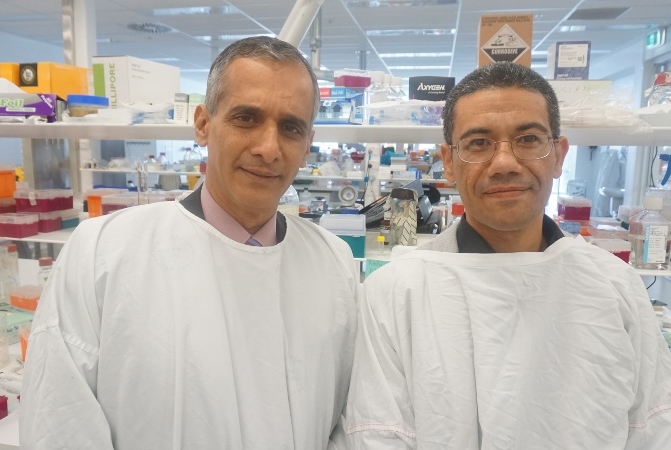April 11, 2017 Print
In a world-first discovery, our scientists have identified a protein that causes liver disease, paving the way for new treatments to be developed.
 Professor Jacob George and Doctor Mohammed Eslam at the Westmead Institute have shown that variations in the interferon lambda 3 protein cause tissue damage in the liver.
Professor Jacob George and Doctor Mohammed Eslam at the Westmead Institute have shown that variations in the interferon lambda 3 protein cause tissue damage in the liver.
More than 6 million Australians living with liver disease may benefit from a world-first discovery from the Westmead Institute that will help predict risk of the disease, enabling life-saving early intervention.
The international team, led by Professor Jacob George and Doctor Mohammed Eslam, has shown that variations in the interferon lambda 3 (INLF3) protein are responsible for tissue damage in the liver.
Lead author of the study, Professor Jacob George, said this significant outcome will help to predict risk of liver disease in individuals and allow early lifestyle changes to control risk factors such as obesity and type II diabetes.
“This important discovery will play a vital role in reducing the burden of liver disease, which is now the fifth most common cause of death in Australia and costs more than $50 billion each year.
“Our team has designed a diagnostic tool based on our discoveries, which is freely available for all doctors to use, to help predict liver fibrosis risk.
“This test will help to determine whether an individual is at high risk of developing liver fibrosis, or whether a patient’s liver disease will progress quickly or slowly, based on their genetic makeup.
“This is important, because simple and early interventions will extend and significantly improve the quality of life for patients and may reduce their need for treatment,” Professor George said.
“Our results show that it is possible to develop new targeted treatments for liver fibrosis and possibly even scarring in other organs such as the heart, lung and kidneys.”
The research team had previously identified that the common genetic variations associated with liver fibrosis were located on chromosome 19 between the IFNL3 and IFNL4 genes.
Building on this research in their latest study, the team analysed liver samples from 2000 patients with Hepatitis C, using state-of-the art genetic and functional analysis, to determine the specific IFNL protein responsible for liver fibrosis.
The research, which is published in the prestigious Nature Genetics journal, demonstrated that following injury there is increased migration of inflammatory cells from blood to the liver, increasing IFNL3 secretion and liver damage.
Notably, this response is determined to a great extent by an individual’s inherited genetic makeup.
Co-lead author, Doctor Mohammed Eslam, said this discovery holds great promise for the development of effective therapeutic treatments for liver disease.
“There is an urgent need for a safe medicines that can stop the progression of liver damage. There is currently no treatment available for patients with advanced fibrosis, and liver transplantation is the only treatment for liver failure.
“Now that we’ve identified IFNL3 as the cause of liver scarring, we can work towards developing new treatments specifically targeting this gene.
“This could be medicine targeting IFNL3 that is tailored to an individual’s genetic makeup, but could also include modifying usual treatment depending on whether a patient has IFNL3 risk genes.
“Our results show that it is possible to develop new targeted treatments for liver fibrosis and possibly even scarring in other organs such as the heart, lung and kidneys," Dr Mohammed concluded.
The research team will now extend their work to further understand the fundamental mechanisms of how IFNL3 contributes to liver disease progression and to translate these discoveries into new therapeutic treatments.
The full research paper is available online at Nature Genetics.
Key facts:
- Liver disease is now the fifth most common cause of death in Australia, affecting 6 million Australians.
- Half of all deaths in the Western world are attributed to disease of tissue scarring, including liver fibrosis.
- It is projected that 8 million Australians will have liver disease by 2030.
- Interferons are naturally occurring proteins that are part of our immune response. There are several types of interferon proteins that, once activated, promote immune attack against viruses and other causes of injury.
- Uncontrolled activation of the IFNL3 protein leads to tissue damage in the liver.